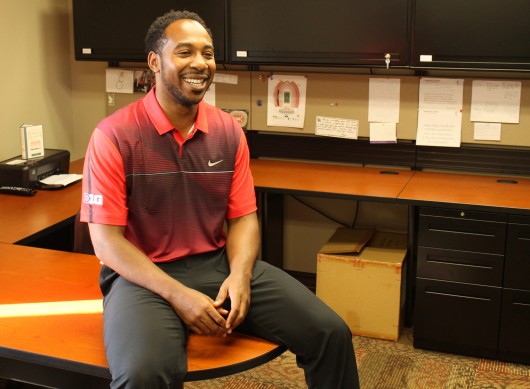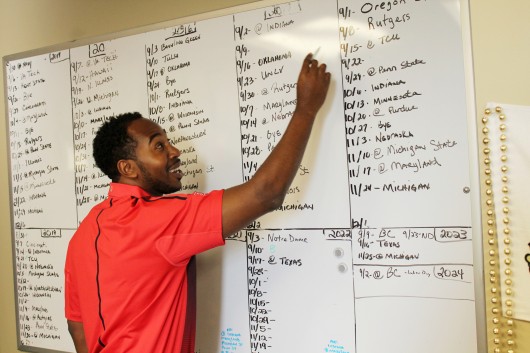
OSU Executive Assosicate Athletic Director Martin Jarmond in an interview with The Lantern Sept. 21 at the Fawcett Center. Credit: Hayden Grove / Lantern TV Sports director
On the outskirts of campus, high above Ohio State’s sprawling array of athletics facilities, sits the office where the gridiron contests held at Ohio Stadium are dreamed up years in advance of when fans will take to the stands.
This office — this epicenter of Buckeye football imagination — houses Martin Jarmond, the executive associate athletic director at OSU, and a series of whiteboards, where current and future OSU football schedules are written out in black marker. Jarmond’s position doesn’t necessarily require him to be responsible for each of those schedules, though. Instead, he specifically asked to create them when he was hired in 2009 at the athletics administration department.
“Quite honestly, I think I probably asked (vice president and athletic director Gene Smith) if I could do that. I think I did,” Jarmond said, a half-smile on his face. “(Football scheduling) was something that was really important to me, that I said I really wanted to do and tackle and help him accomplish the vision he wants to accomplish.”
So far, Smith said he has been more than pleased with his decision to allow Jarmond to handle the scheduling, along with his other responsibilities as an athletic administrator.
“Martin has developed into an outstanding athletic administrator. He continues to differentiate himself as a leader,” Smith said in an email. “His background as a collegiate athlete, and various roles in athletic administration strengthens his opportunity to reach his goal of becoming an athletic director.”
Jarmond played basketball while attending the University of North Carolina-Wilmington.
While his boss might understand the daily grind that Jarmond goes through to put the Buckeyes’ football schedule together, not all OSU or college football fans do.
Jarmond said there are many variables and challenges that are presented in creating a football schedule, and he calls planning for the Buckeyes “the process.” It begins with Smith and the desires he spells out for Jarmond.
“His (scheduling strategy) that he’s outlined is at least trying to have a top 10-team opponent every year, then a top 25, top 30-type opponent and then maybe a top 50 or what you can attract,” Jarmond said. “It’s mostly about what you can attract.”
With his boss sketching the scheduling outline, specifically tailored to feature big-time, out-of-conference opponents, it’s Jarmond’s responsibility to color within the proverbial lines.
“The way we do it is from a competitive standpoint,” Jarmond said. “I look at data from the last five years. I try to look at teams, schools, how they’ve done, their coaching, their philosophy, their offense, their defense and that kind of thing.”
That research manifests itself in the form of a list of schools that both Jarmond and Smith believe will aptly play the role of an OSU opponent.
That list can include a wide array of schools, each of which is put through additional rigors that include the potential national relevance of a future matchup, the effect that a game against that school will have on recruiting and even the institution’s proximity to an OSU fan base. Those factors in turn lead to churning out another list.

OSU Executive Assosicate Athletic Director Martin Jarmond highlights future OSU football schedules Sept. 21 at the Fawcett Center.
Credit: Hayden Grove / Lantern TV Sports director
This list is the one where the next step of the scheduling process begins: the phone calls.
It was amidst these phone calls and negotiations that Jarmond said he faced a surprising challenge in his early days as an OSU administrator. Getting opponents to Columbus was a challenge — one he did not expect.
“I think — naively — I was probably thinking because we’re Ohio State, it would just be very easy and everybody would want to play us and it would be easy to work things through,” Jarmond said. “It’s not like, ‘Wow, we’d love to come to Columbus in front of 107,000.’ I thought it was going to be that way — it’s not really that way.”
And some opponents might not want to spend money traveling to a city where they could potentially lose.
The lack of desire to travel to Columbus makes things harder for Jarmond in scheduling opponents, along with the other factors that make it a tough job.
Jarmond already has to account for things like an expanded Big Ten schedule (to nine from eight games per season in 2016) and the College Football Playoff that will take into account strength of schedule more so than the old BCS system did. These things are an added burden for Jarmond and are only lengthening planning lead time, forcing schedules until 2020 to be planned now.
“It’s an inventory issue, if you’re trying to schedule stronger, you need to go ahead and do what you can do now before (other schools say), ‘Hey, we can’t play you because we don’t have anything available,’” Jarmond said. “Everything is just kind of accelerated and you have to kind of project out and where teams are going to be.”
In the past, Jarmond admitted that this advanced planning has harmed OSU, with teams like California projecting well at the initial time of scheduling before taking a dive in relevancy prior to the two schools playing, but he tries to avoid those issues recurring in the future.
“It’s an inexact science, but what I try to do is use the data as much as I can on where you’ve been to kind of give us an idea of where you may be,” Jarmond said. “It’s like the stock market. You look at past performance and you try to project on that.”
Lately, Jarmond — with some added motivation from Smith and the fans who have bashed OSU’s football non-conference scheduling over the years — has been pressing to bolster OSU’s future schedules. Ari Wasserman of Cleveland.com said that’s something OSU has been forced to do, thanks to a weakened Big Ten conference.
“(The Buckeyes) don’t get any quality wins in the Big Ten because the Big Ten doesn’t really have any premier opponents,” Wasserman said. “Going undefeated in the Big Ten may be enough to get to the playoff, but maybe when they play a team like Oklahoma and slip up, bolstering their schedule is a really smart thing to do. You’re going to have quality wins in the future with the games they’ve scheduled.”
Oklahoma is just one of the schools Jarmond has added to the schedule, but there are plenty of other out-of-conference games gracing that whiteboard on his wall.
Notre Dame, Boston College, Oregon State, Oregon, Texas and Texas Christian are all future opponents and it’s these additions that provide Jarmond with confidence in the work he’s done.
“I would put our scheduling (from) 2016 and out compared to anybody,” Jarmond said, glancing at the board. “You tell me another school right now that has BC, Texas and Notre Dame in the same year.”
When the Buckeyes take on the Bearcats on Saturday, fans might not pay much attention to the effort and work that went into scheduling an in-state rivalry game. They’ll be watching to see if the Buckeyes can hold back Cincinnati’s redshirt-sophomore quarterback Gunner Kiel, or whether OSU redshirt-freshman quarterback J.T. Barrett can win yet another Big Ten Freshman of the Week award.
While Jarmond will certainly be watching the same action, he’ll have a different view of the game — one that few others in Ohio Stadium will have.
He’ll be watching planning come to life upon the turf.


